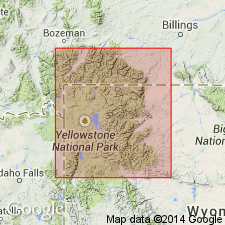
- Usage in publication:
-
- Lamar River Formation*
- Modifications:
-
- Named
- Dominant lithology:
-
- Lava
- Conglomerate
- Tuff
- Breccia
- AAPG geologic province:
-
- Yellowstone province
Summary:
Named a formation in Washburn Group of Absaroka Volcanic Supergroup for exposures (type area) along valley walls of Lamar River and its tributaries in Yellowstone National Park, Yellowstone province, WY. Formerly included in early basic breccia. Divided into conglomerate facies, Elk Creek Basalt Member, and epiclastic volcanic sediments. Consists of well-bedded coarse alluvial facies, volcanic conglomerates, breccias, and tuffs that contain some of the best-preserved fossil forests in Park. Sections on northeast side Specimen Ridge and in lower half of valley walls of Soda Butte Creek, Barronette and Abiather Peaks are coalesced deposits of epiclastically reworked material and air-fall tuffs from several andesitic volcanoes. A plug along Sulphur Creek of fine- to medium-grained diorite is an intrusive phase of Lamar River. Locally brecciated andesite intrusives occur as sheets and lenses that can be as much as 1,000 ft of total section. Thickest (3,200 ft) in the vent facies in southeastern part of Washburn Range. Alluvial facies ranges from 500 to 2,200 ft thick along Soda Butte Creek. Grades west into well-dated Sepulcher Formation. Overlies rocks ranging in age from Precambrian to middle Eocene. Locally unconformably overlies faulted and tilted Sepulcher. Unconformably overlain by Langford Formation. Assigned to late early to early middle Eocene. Has an early Bridgerian fossil flora.
Source: GNU records (USGS DDS-6; Denver GNULEX).
For more information, please contact Nancy Stamm, Geologic Names Committee Secretary.
Asterisk (*) indicates published by U.S. Geological Survey authors.
"No current usage" (†) implies that a name has been abandoned or has fallen into disuse. Former usage and, if known, replacement name given in parentheses ( ).
Slash (/) indicates name conflicts with nomenclatural guidelines (CSN, 1933; ACSN, 1961, 1970; NACSN, 1983, 2005, 2021). May be explained within brackets ([ ]).

